20 Ducks With Black Bills (with Pictures)
In the world of ducks, color often tells a quiet story. While some ducks show off bright patches of green, chestnut, or blue, their bills reveal a lot too — not just about how they look, but how they live.
A black beak might seem plain next to a bright orange or yellow one, but it has important advantages. For many ducks, especially females, dark bills help with camouflage, blending in with reeds and muddy water where they nest. The darker color also hides stains from mud and algae, keeping the bill looking clean even with constant feeding and preening.
From the great scaups to the gentle female surf scoters, ducks with black beaks show how nature values usefulness as much as beauty.
Let’s take a closer look at some of these ducks to learn more about their habitats, behavior, feeding and nesting habits, and other interesting facts.
- 1. Northern Pintail
- 2. Greater Scaup
- 3. Lesser Scaup
- 4. Hardhead
- 5. Cayuga Duck
- 6. African Black Duck
- 7. Hooded Merganser
- 8. Pacific Black Duck
- 9. Blue-winged Teal
- 10. Knob-billed Duck
- 11. Bufflehead Duck
- 12. Female Tufted Duck
- 13. Female Ruddy Duck
- 14. Female Pochard
- 15. Female Common Eider
- 16. Female King Eider
- 17. Female Surf Scoter
- 18. Female White-winged Scoter
- 19. Female Velvet Scoter
- 20. Some American Black Ducks
1. Northern Pintail
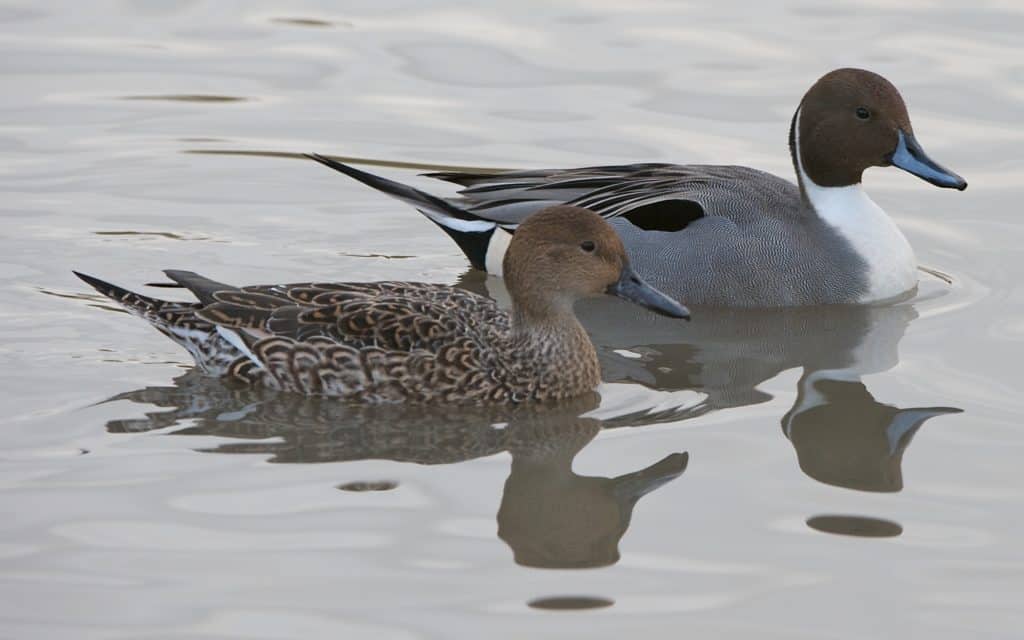
The Northern Pintail is a graceful, long-necked duck that you can spot across the northern parts of the world. It’s known for its sleek look and the male’s long, pointed tail that gives the species its name. Both males and females have dark, almost black bills that stand out beautifully against their smooth feathers.
The male looks especially elegant with a chocolate-brown head, a white stripe running down his neck, and soft grey sides, while the female wears a more camouflaged mix of browns and greys.
These ducks love open wetlands, where they wade and dabble for seeds, aquatic plants, and small insects. They often travel in flocks, especially outside the breeding season, and their soft whistles and quacks are a gentle sound across northern ponds and marshes.
2. Greater Scaup
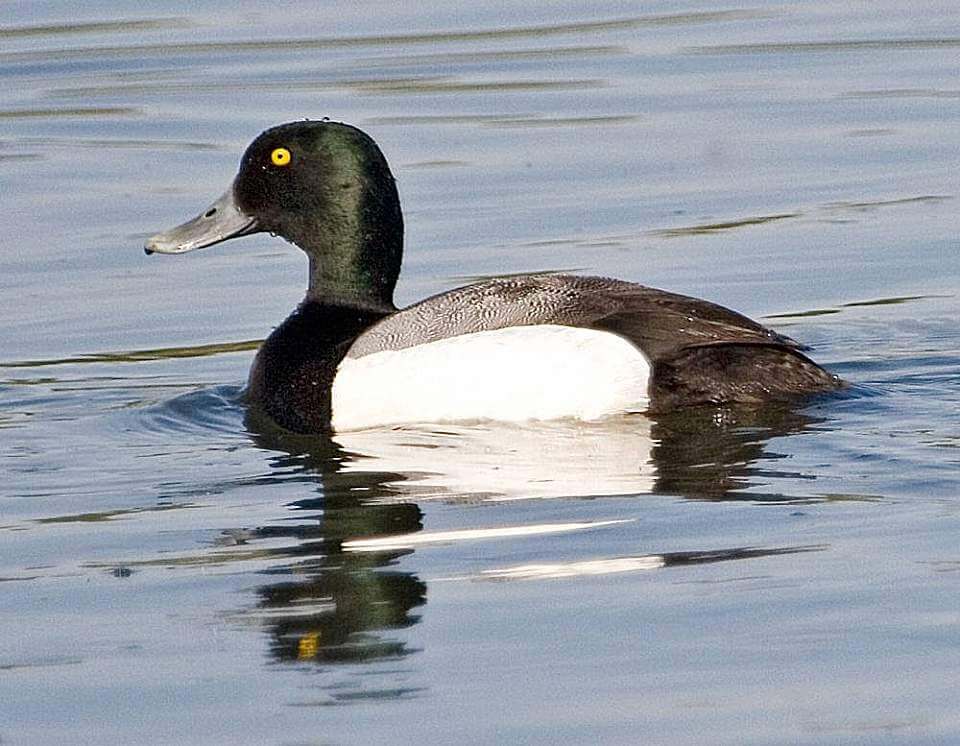
If you ever see a group of round, diving ducks with bright yellow eyes and dark beaks, you might be looking at Greater Scaups.
These sturdy ducks have glossy greenish-black heads (in males) and grey backs, with pure white sides that shine when they’re out of the water. Females are chocolate-brown with a paler face patch near the base of their black bill.
They’re diving experts, plunging underwater to feed on shellfish, seeds, and small aquatic animals.
Greater Scaups are sociable birds, often seen in large rafts on lakes or coastal waters, especially in winter.
Their black beaks, paired with those vivid yellow eyes, make them easy to recognize even from a distance.
3. Lesser Scaup
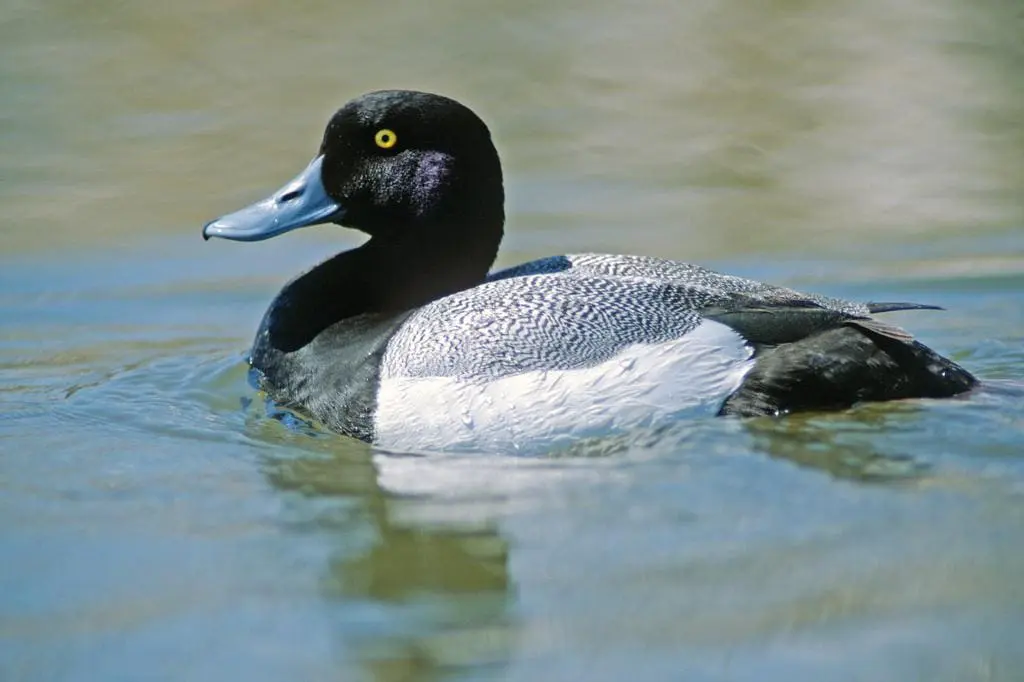
The Lesser Scaup looks a lot like the Greater Scaup but is a bit smaller and more common across North America.
Both males and females have dark, nearly black beaks that help set them apart from other diving ducks. The male’s head often shines with a purple or bluish tint in the sunlight, while the female has a softer brown coat with a white patch near the bill.
These ducks are active divers, feeding mostly on insects, snails, and aquatic plants. If you watch closely, you’ll notice how they often travel in flocks that rest and feed together, dipping beneath the surface again and again.
Their black beaks and bright eyes give them a curious, alert look that birdwatchers love.
4. Hardhead
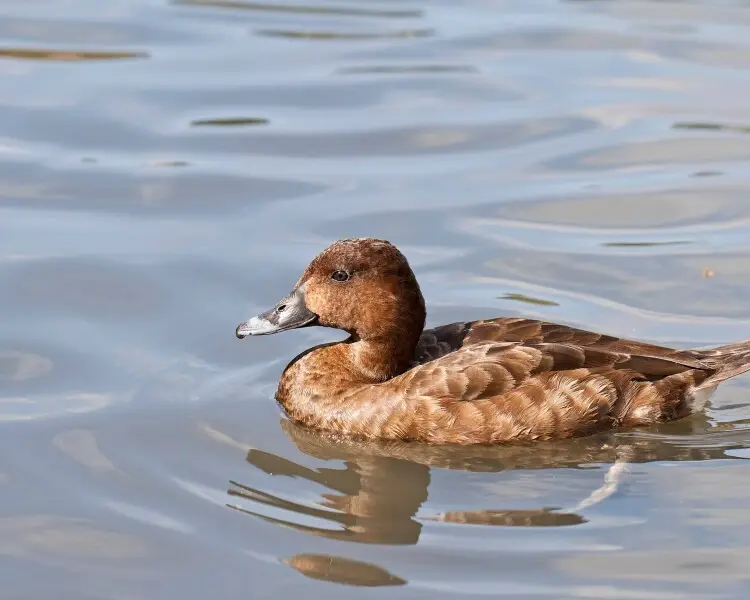
The Hardhead, also called the White-eyed Duck, is an Australian favorite — and the country’s only true diving duck.
Both males and females have deep brown plumage and short, dark, almost black beaks that match their sleek bodies. Males stand out with their clear white eyes, while females have brown ones.
They prefer quiet, sheltered lakes, swamps, and wetlands, where they dive for food such as insects, seeds, and small aquatic animals.
Despite the name, “Hardhead” doesn’t mean their heads are tough — it actually came from early taxidermists who found their skins tricky to work with!
These ducks are shy but fascinating to watch, especially when they disappear underwater in search of food and pop back up a few moments later.
5. Cayuga Duck
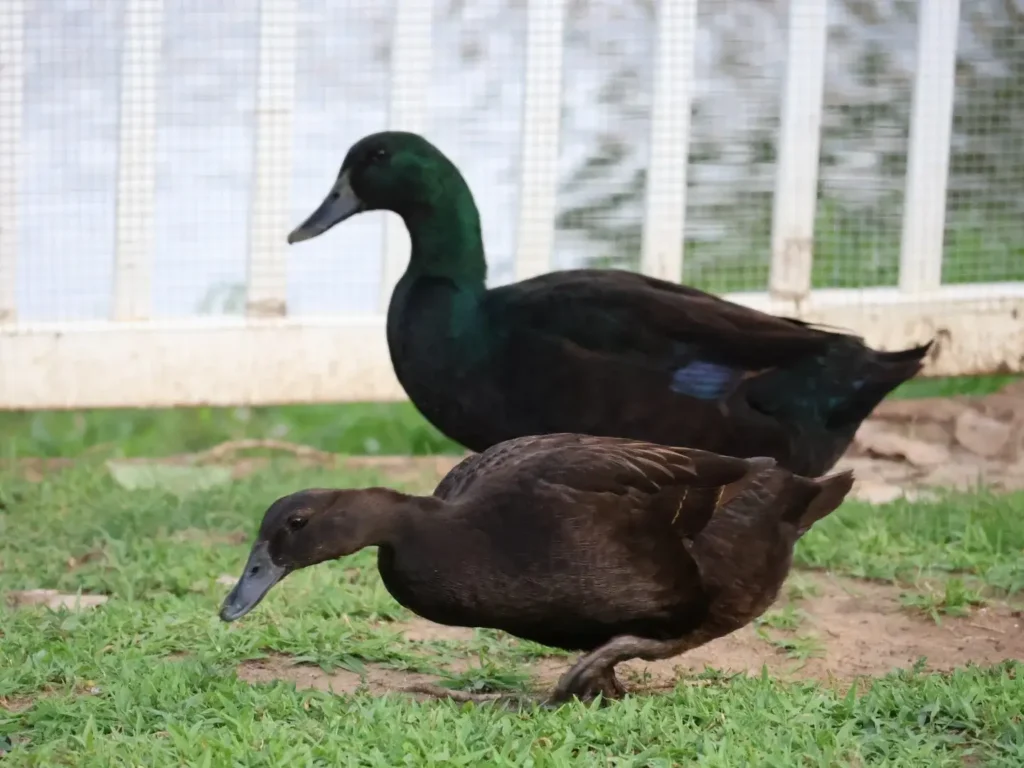
The Cayuga Duck is a beautiful, glossy bird that shines with shades of green and blue when the sunlight hits its black feathers.
This American breed was first raised in New York’s Finger Lakes region and named after the Cayuga people.
Both males and females have deep black beaks that perfectly match their dark plumage, giving them a sleek, polished look.
Over time, some older ducks may show a few white feathers, almost as if their color fades with age.
Cayugas were once prized for their meat, but today, they’re mostly kept for their beauty and calm nature.
If you ever see one on a pond, you’ll notice how elegant and peaceful they look gliding across the water.
6. African Black Duck
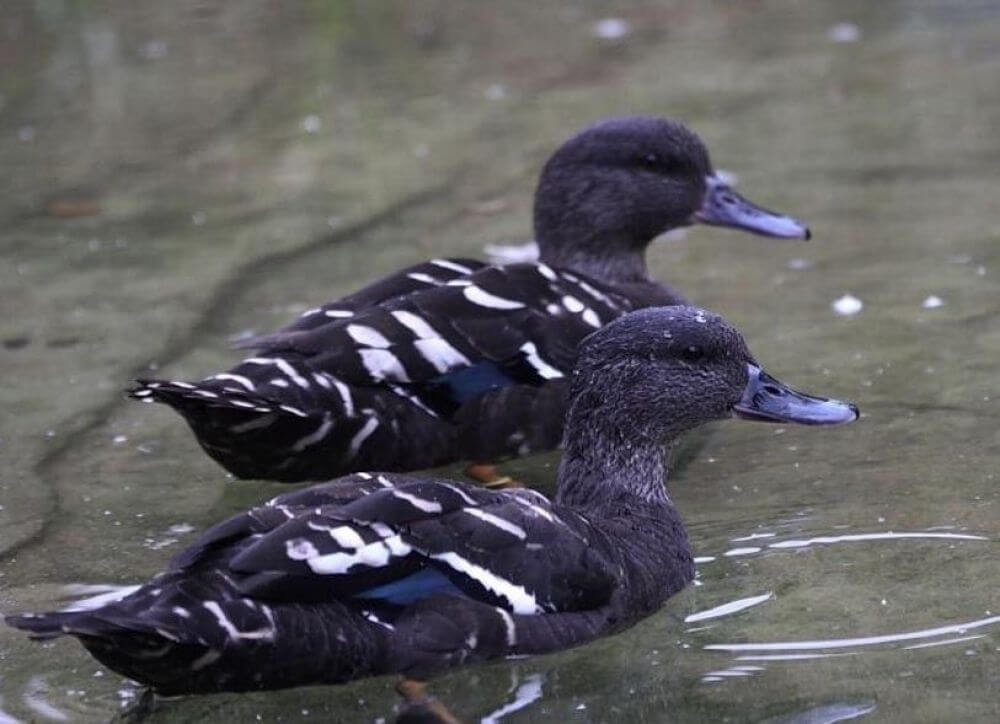
The African Black Duck is a striking species often seen in the fast-moving rivers and streams of central and southern Africa.
Its dark feathers are splashed with white patches on the back, making it look like ripples of sunlight are dancing on its body. It has a strong, dark beak—almost black—that it uses to pick food from shallow waters. Its purple-blue wing patch (called a speculum) flashes in flight, adding to its beauty.
Though it’s related to the mallard, this duck behaves differently—more shy and secretive, often staying near cover. Watching one means being patient and quiet, as it prefers the sound of rushing water to busy wetlands.
7. Hooded Merganser
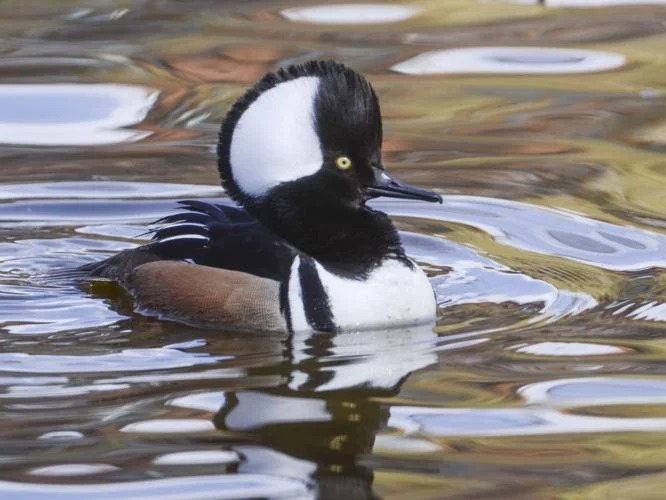
Both males and most females have thin, dark bills—perfect for catching slippery fish underwater. The male is especially showy with his white, fan-shaped crest that he can raise like a hood, giving him his name. Females are more softly colored in brown and tan, but still share that same curious crest.
These North American ducks are excellent divers, using their sharp, saw-edged black beaks to grab fish and aquatic insects. If you spot one on a quiet lake or river, you might see it disappear below the surface for several seconds before popping up somewhere else with a tiny fish in its bill.
8. Pacific Black Duck
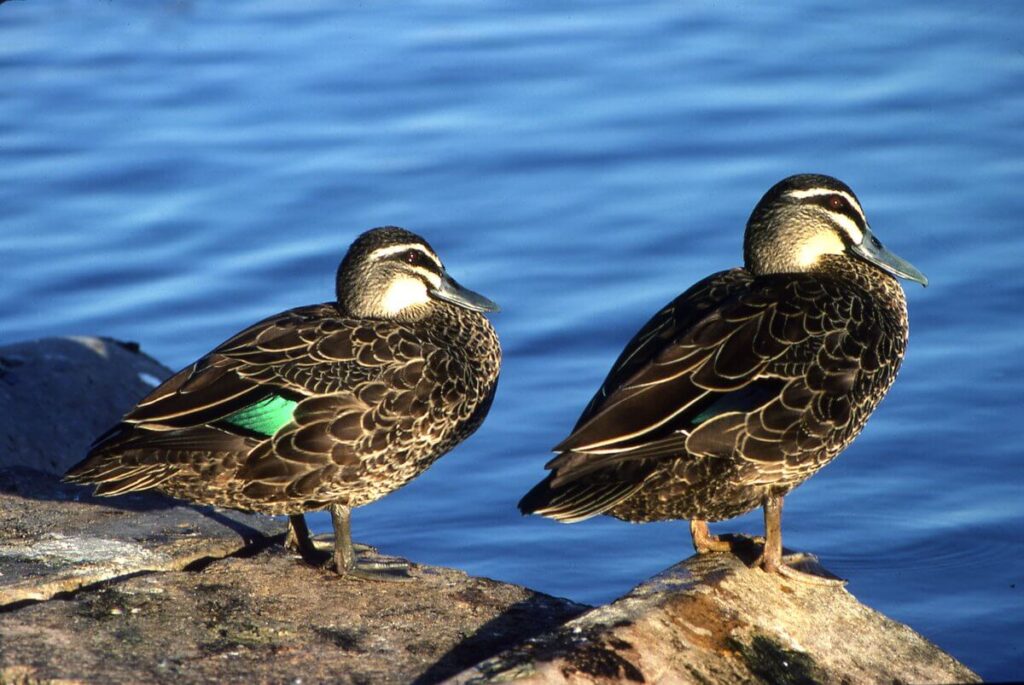
The Pacific Black Duck, often called the “PBD,” is one of the most familiar and widespread ducks across Australia, New Zealand, and nearby islands. Its name fits perfectly—it has dark, smoky-brown feathers and a bold black beak that blends seamlessly with its face stripes.
In flight, you can see its shining green wing patch, which adds a flash of color against its otherwise earthy tones.
These ducks are strong fliers and love calm wetlands, rivers, and lakes. They’re friendly, often seen feeding alongside other ducks or upending in shallow water to reach plants below.
Many birdwatchers adore the Pacific Black Duck for its gentle quack and its calm, confident presence wherever it goes.
9. Blue-winged Teal
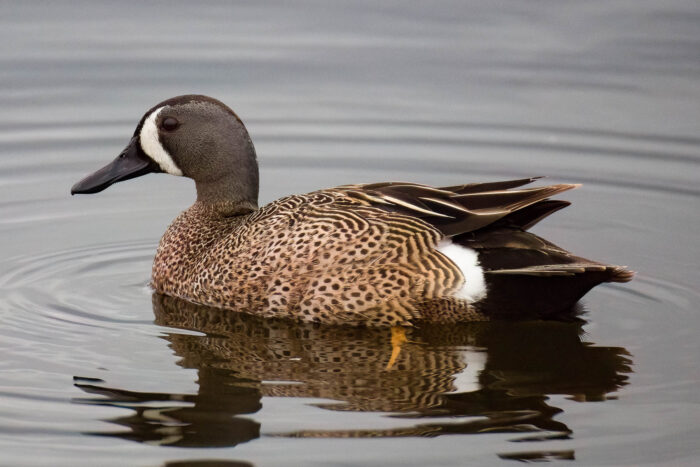
The Blue-winged Teal is a small, graceful duck that many birdwatchers love spotting during migration season. It gets its name from the bright sky-blue patches on its wings that flash when it flies.
Both males and females have dark gray to black beaks, which they use to sift through shallow water for seeds, insects, and small aquatic creatures. The male is especially eye-catching with his soft blue-gray head and a white crescent marking in front of the eye. Females are more brown and speckled but just as charming when you catch them dabbling in calm ponds or marshes.
Blue-winged Teals are among the first ducks to fly south for winter, traveling all the way to Central and South America—quite the journey for such a small bird!
10. Knob-billed Duck
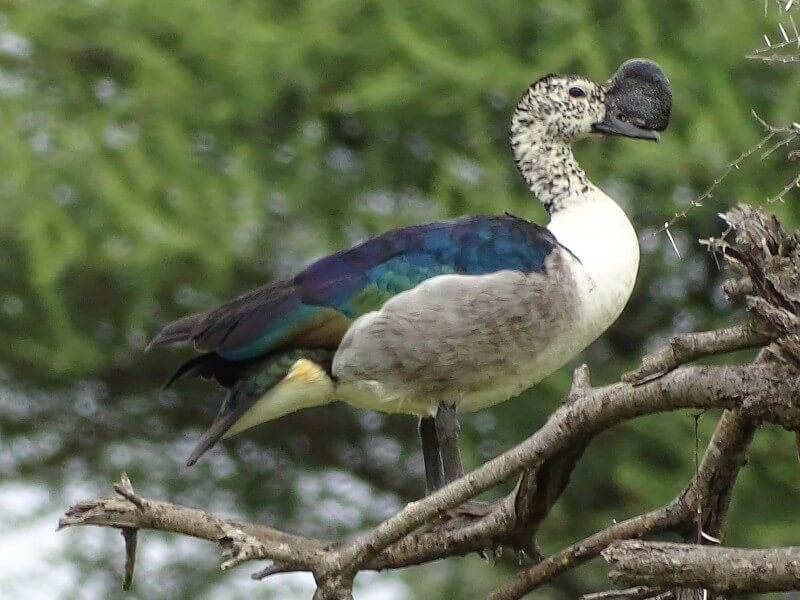
The Knob-billed Duck, also called the Comb Duck, is a large and unusual-looking waterbird found across Africa and parts of Asia. It’s easy to recognize by its glossy, blackish-blue back and the big black bump—or “knob”—on the male’s beak. That knob gives the species its name!
Both males and females have dark, nearly black bills, but the males’ is more dramatic.
These ducks love open freshwater areas like lakes and marshes, where they quietly feed on plants and small aquatic animals. They’re not very talkative—usually silent except for a soft croak when startled.
11. Bufflehead Duck
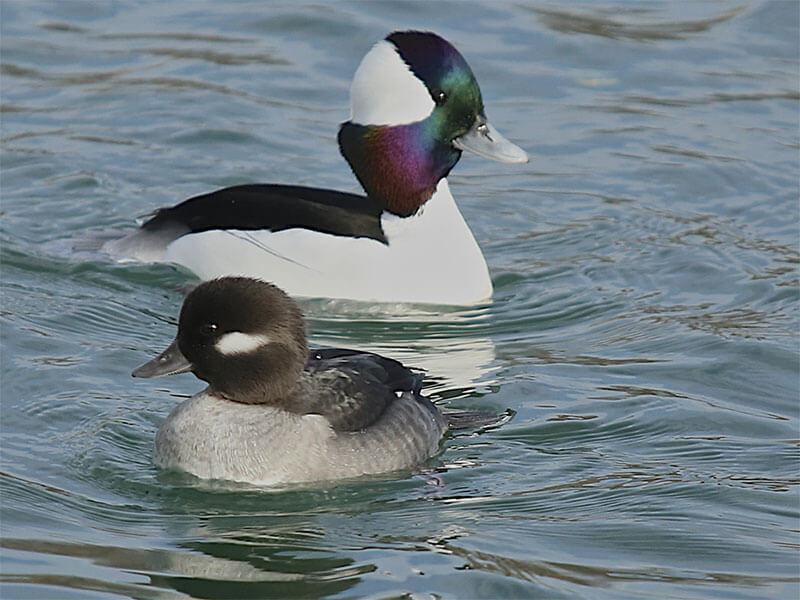
The Bufflehead Duck is one of North America’s smallest and most energetic diving ducks.
Males have shiny black-and-white feathers, with a head that glows with purple and green hues in the sunlight, while females wear a softer gray-and-brown coat. Both have short, neat black bills that they use to catch insects, small crustaceans, and tiny fish underwater.
They’re fast divers and can disappear below the surface in a blink! Buffleheads often nest in old woodpecker holes, especially those made by Northern Flickers, which makes them quite resourceful. If you see one on a quiet lake, watch for its quick dives and cheerful bobs on the water—it’s a small duck with a big personality.
12. Female Tufted Duck
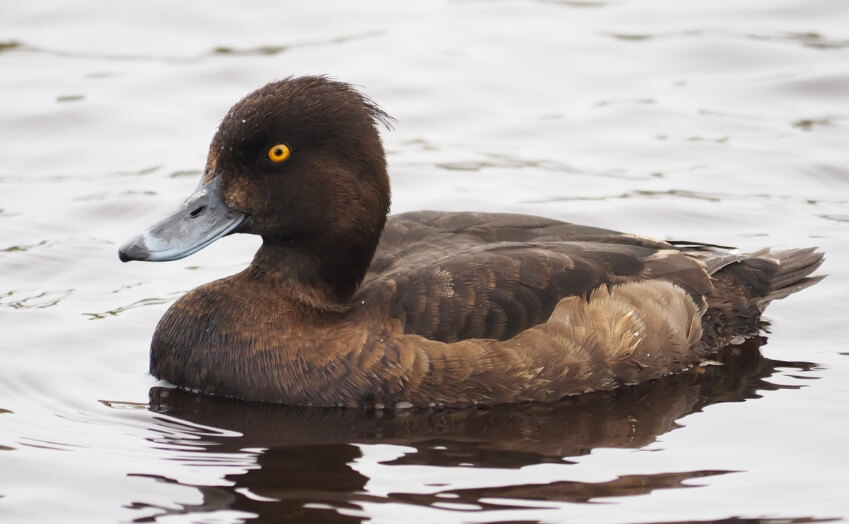
The female Tufted Duck may not be as flashy as the male, but she has her own kind of quiet beauty. Her soft chocolate-brown feathers help her blend in perfectly with reeds and pond edges, keeping her safe while nesting.
Unlike the male’s striking yellow eyes and glossy black feathers, the female’s look is more subtle—but her small, dark bill stands out clearly against her face. This black beak is perfect for diving and scooping up snails, aquatic plants, and insects from the lake bottom.
If you spot her on calm water, you’ll notice she often dives again and again with smooth precision, popping up like a little cork each time.
13. Female Ruddy Duck
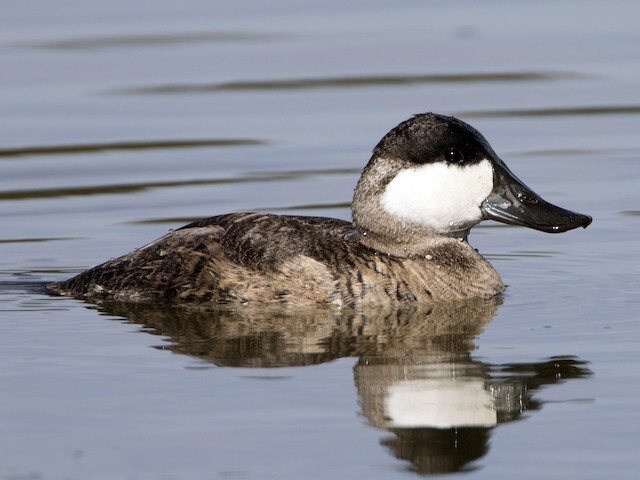
The female Ruddy Duck might look plain at first, but she’s full of charm if you take a closer look. Her body is covered in soft brown feathers with a faint dark cap on her head and a light cheek patch.
Her bill is dark—almost black—short, and sturdy, ideal for diving and feeding on underwater insects and seeds. She’s smaller than most ducks and tends to keep to herself, gliding quietly on ponds and marshes.
While the male shows off bright colors and a sky-blue bill during breeding season, the female features a more modest look—perfect camouflage when nesting among reeds.
14. Female Pochard
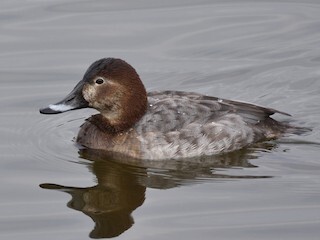
Female Pochards are elegant divers with warm brown feathers and a soft grayish face that gives them a gentle look. Their dark, nearly black bills have a faint lighter band near the tip—just enough to catch the light when they turn their heads.
These ducks spend a lot of time underwater searching for food like aquatic plants, seeds, and small insects. They’re calm and steady swimmers, often spotted alongside males with chestnut heads and red eyes.
The female’s muted tones may seem simple, but they’re perfectly suited for nesting quietly among reeds, where blending in can mean the difference between safety and danger.
15. Female Common Eider
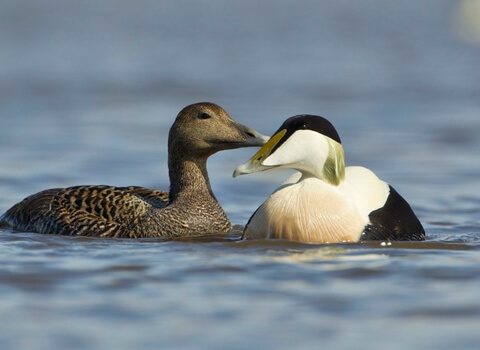
The female Common Eider is the definition of strength and survival in the cold north. Covered in beautifully patterned brown feathers, she relies on her coloring to hide her nest on rocky shores or grassy tundra.
Her bill is long, sloping, and dark gray to black—built for scooping up her favorite food: mussels and other shellfish. She’s larger than many other ducks, and her thick down feathers help her stay warm in icy waters.
Eiders are also known for their soft, warm eiderdown, which humans have prized for centuries. Watching a female eider care for her chicks shows just how tough and devoted these Arctic mothers are.
16. Female King Eider
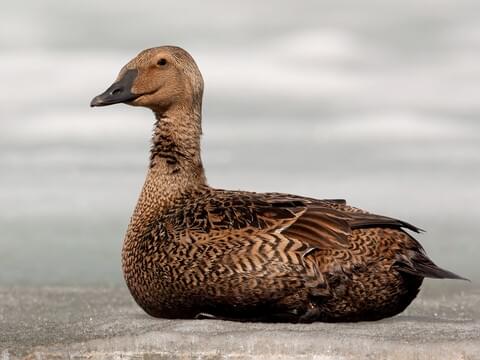
The female King Eider might not have the male’s bold colors, but she’s just as regal in her own right. Her feathers are a rich mix of browns and tans, patterned like rippling sand, helping her stay hidden along rocky Arctic coastlines. Her bill is dark gray to black, smooth, and slightly curved—perfect for grabbing clams and crustaceans from the seafloor.
She spends most of her time in frigid northern waters, where few other ducks dare to go. Watching a female King Eider float on icy waves is a reminder of how perfectly adapted these birds are to their cold, harsh home.
17. Female Surf Scoter
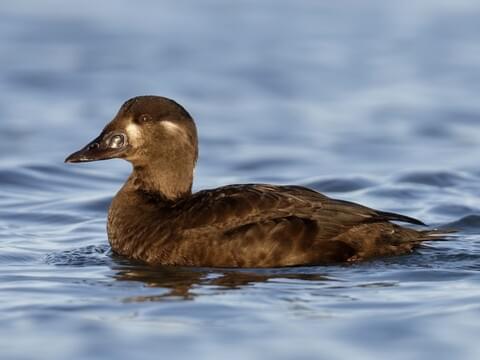
The female Surf Scoter is a sea-loving duck with soft brown feathers that help her blend into coastal waters. Her bill is dark—almost black—and stout, ideal for scooping up mollusks, small fish, and crustaceans from the ocean surface or just below.
While the male is boldly patterned with black and white patches, the female’s subtle coloring keeps her hidden while she forages or tends to her young along shorelines and bays.
18. Female White-winged Scoter
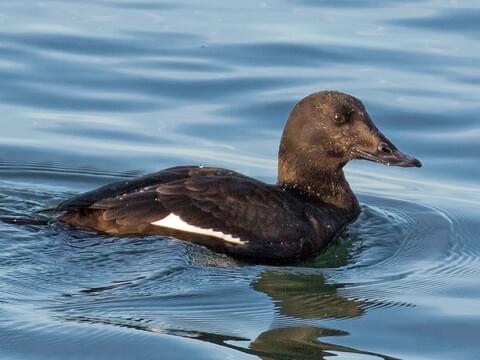
The female White-winged Scoter is a striking duck in her understated way. She’s mostly dark brown with a pale cheek patch that lightens her face. Her bill is black, strong, and slightly compressed—perfect for digging into the water for mussels, snails, and other invertebrates.
Unlike the flamboyant male with its white wing patches, she is mostly muted in color, helping her stay safe while nesting on freshwater lakes or coastal inlets. She swims and dives with ease, and her calm movements are a joy to watch.
19. Female Velvet Scoter
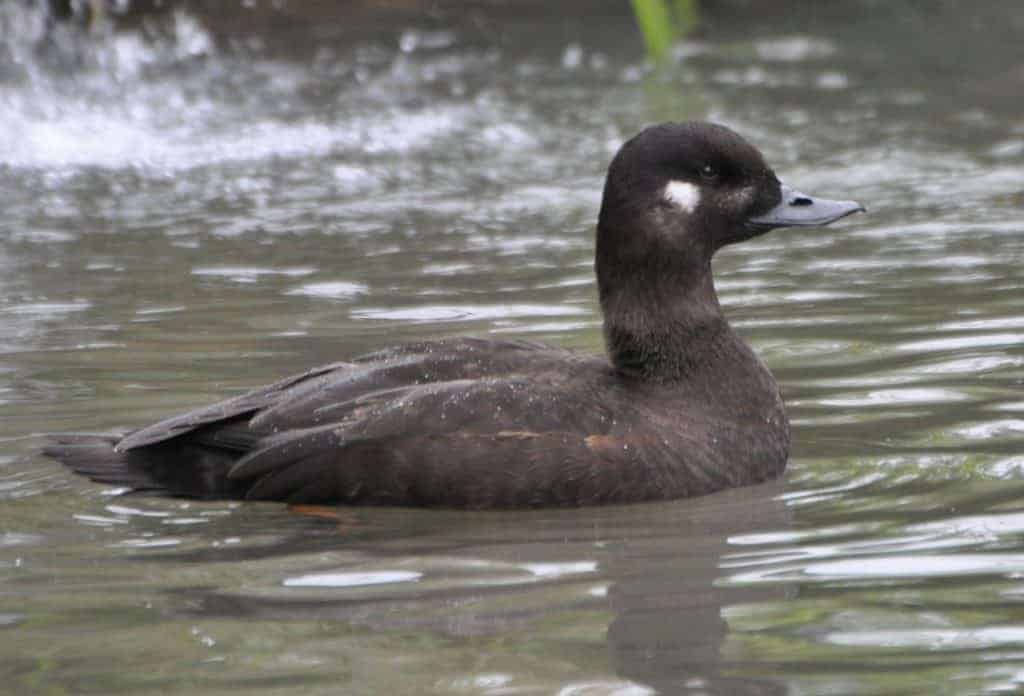
The female Velvet Scoter may not flash bright colors, but her presence is commanding. She wears warm brown feathers and a darker crown that helps her blend into open sea and coastal waters. Her bill is black, short, and tough—excellent for prying shellfish and small crustaceans from rocks and sand.
These scoters are excellent divers and can stay submerged longer than many other ducks. If you watch carefully, you’ll notice how she maneuvers through choppy waters with grace and skill, always ready to surface with a fresh snack.
20. Some American Black Ducks
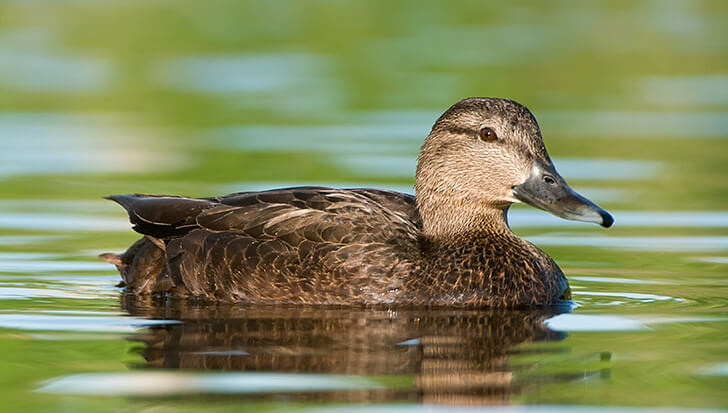
Some American Black Ducks, especially the females, are covered in soft brown feathers with subtle darker streaks. Their bills are dark, often black or very deep olive, and broad, making them perfect for dabbling in ponds, marshes, and slow-moving rivers.
While males often show more glossy feathers and subtle highlights, the females stay low-key, staying hidden in reeds and grasses. These black-beaked ducks are excellent foragers, carefully sifting through plants and small invertebrates for food.
